英语十六时态表格完整总结
- 格式:doc
- 大小:45.00 KB
- 文档页数:6
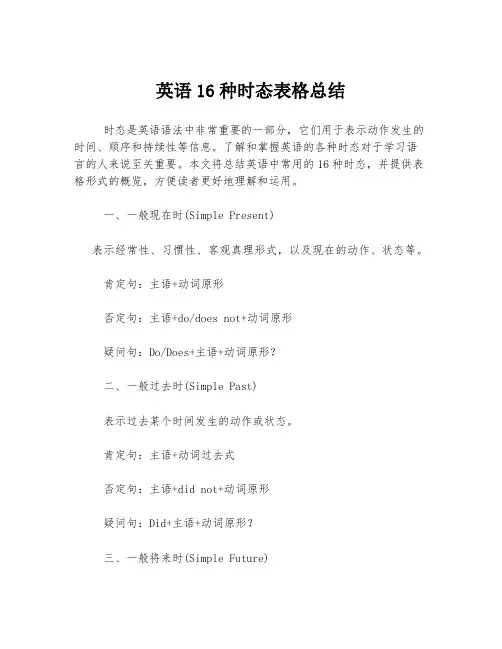
英语16种时态表格总结时态是英语语法中非常重要的一部分,它们用于表示动作发生的时间、顺序和持续性等信息。
了解和掌握英语的各种时态对于学习语言的人来说至关重要。
本文将总结英语中常用的16种时态,并提供表格形式的概览,方便读者更好地理解和运用。
一、一般现在时(Simple Present)表示经常性、习惯性、客观真理形式,以及现在的动作、状态等。
肯定句:主语+动词原形否定句:主语+do/does not+动词原形疑问句:Do/Does+主语+动词原形?二、一般过去时(Simple Past)表示过去某个时间发生的动作或状态。
肯定句:主语+动词过去式否定句:主语+did not+动词原形疑问句:Did+主语+动词原形?三、一般将来时(Simple Future)表示将要发生的动作或状态。
肯定句:主语+will+动词原形否定句:主语+will not+动词原形疑问句:Will+主语+动词原形?四、现在进行时(Present Continuous)表示现在正在进行的动作或状态。
肯定句:主语+am/is/are+动词现在分进行否定句:主语+am/is/are not+动词现在分进行疑问句:Am/Is/Are+主语+动词现在分进行?五、过去进行时(Past Continuous)表示过去某个时间正在进行的动作或状态。
肯定句:主语+was/were+动词现在分进行否定句:主语+was/were not+动词现在分进行疑问句:Was/Were+主语+动词现在分进行?六、将来进行时(Future Continuous)表示将来某个时间正在进行的动作或状态。
肯定句:主语+will be+动词现在分进行否定句:主语+will not be+动词现在分进行疑问句:Will+主语+be+动词现在分进行?七、现在完成时(Present Perfect)表示过去发生的动作对现在造成的影响或结果。
肯定句:主语+have/has+动词过去分词否定句:主语+have/has not+动词过去分词疑问句:Have/Has+主语+动词过去分词?八、过去完成时(Past Perfect)表示过去某个时间之前发生的动作。
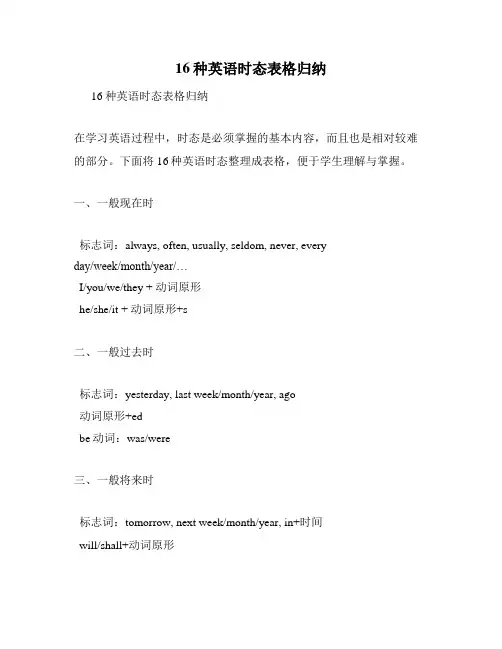
16种英语时态表格归纳16种英语时态表格归纳在学习英语过程中,时态是必须掌握的基本内容,而且也是相对较难的部分。
下面将16种英语时态整理成表格,便于学生理解与掌握。
一、一般现在时标志词:always, often, usually, seldom, never, everyday/week/month/year/…I/you/we/they + 动词原形he/she/it + 动词原形+s二、一般过去时标志词:yesterday, last week/month/year, ago动词原形+edbe动词:was/were三、一般将来时标志词:tomorrow, next week/month/year, in+时间will/shall+动词原形四、现在进行时标志词:now, at the moment, right now, currently am/is/are+现在分词五、过去进行时标志词:at+时间,when, whilewas/were+现在分词六、将来进行时标志词:at+时间will/shall+be+现在分词七、现在完成时标志词:ever, never, already, yet, justhave/has+过去分词八、过去完成时标志词:before, by the timehad+过去分词九、将来完成时标志词:by+时间will/shall+have+过去分词十、一般过去时被动语态标志词:被动语态was/were+过去分词十一、现在完成时被动语态标志词:被动语态have/has+been+过去分词十二、过去完成时被动语态标志词:被动语态had+been+过去分词十三、一般将来时被动语态标志词:被动语态will/shall+be+动词过去分词十四、现在进行时被动语态标志词:被动语态am/is/are+being+过去分词十五、过去进行时被动语态标志词:被动语态was/were+being+过去分词十六、将来进行时被动语态标志词:被动语态will/shall+be+being+过去分词以上是英语16种时态的表格汇总,当然还有很多语法细节需要注意,而且有些时态在实际使用过程中还会存在一些变化。
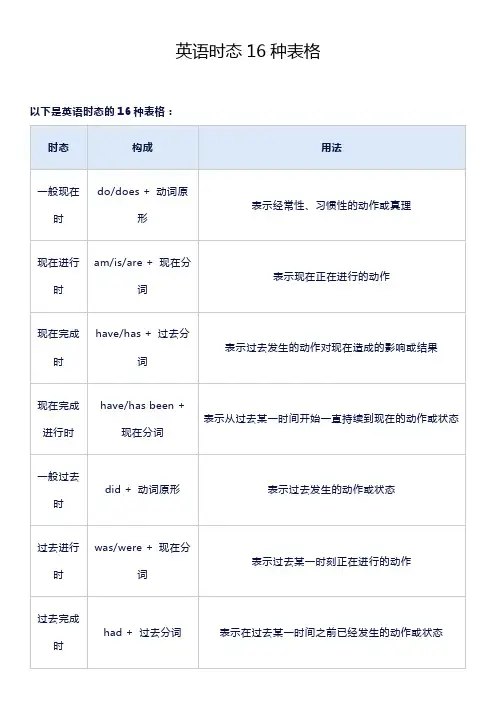
英语时态16种表格以下是英语时态的16种表格:基本时态(12种):1.一般现在时(Simple Present)o结构:主语+ 动词原形/动词的第三人称单数形式o示例:I walk to school every day. (我每天步行上学。
)2.一般过去时(Simple Past)o结构:主语+ 过去式动词o示例:She worked at the library yesterday. (她昨天在图书馆工作。
)3.一般将来时(Simple Future)o结构:主语+ will/shall + 动词原形o示例:He will study abroad next year. (他明年将出国留学。
)4.现在进行时(Present Continuous)o结构:主语+ am/is/are + 动词-ing形式o示例:They are watching TV now. (他们现在正在看电视。
)5.过去进行时(Past Continuous)o结构:主语+ was/were + 动词-ing形式o示例:We were playing football when it started raining. (下雨的时候我们正在踢足球。
)6.将来进行时(Future Continuous)o结构:主语+ will be + 动词-ing形式o示例:I will be cooking dinner at 7 p.m. tonight. (今晚7点我将会在做饭。
)7.现在完成时(Present Perfect)o结构:主语+ have/has + 过去分词o示例:She has finished her homework already. (她已经完成了作业。
)8.过去完成时(Past Perfect)o结构:主语+ had + 过去分词o示例:They had left before I arrived. (在我到达之前他们就已经离开了。
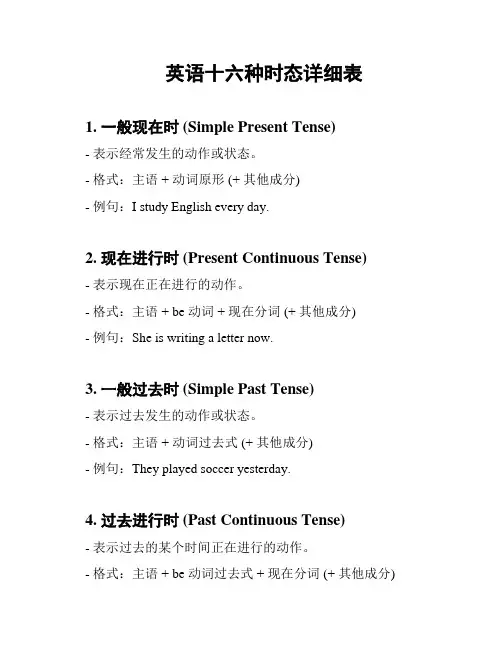
英语十六种时态详细表1. 一般现在时 (Simple Present Tense)- 表示经常发生的动作或状态。
- 格式:主语 + 动词原形 (+ 其他成分)- 例句:I study English every day.2. 现在进行时 (Present Continuous Tense)- 表示现在正在进行的动作。
- 格式:主语 + be 动词 + 现在分词 (+ 其他成分)- 例句:She is writing a letter now.3. 一般过去时 (Simple Past Tense)- 表示过去发生的动作或状态。
- 格式:主语 + 动词过去式 (+ 其他成分)- 例句:They played soccer yesterday.4. 过去进行时 (Past Continuous Tense)- 表示过去的某个时间正在进行的动作。
- 格式:主语 + be 动词过去式 + 现在分词 (+ 其他成分)- 例句:He was studying when I called him.5. 现在完成时 (Present Perfect Tense)- 表示过去发生的动作对现在产生的影响或仍然持续的动作。
- 格式:主语 + have/has + 过去分词 (+ 其他成分)- 例句:I have visited Paris.6. 过去完成时 (Past Perfect Tense)- 表示过去某个时间或动作之前发生的动作。
- 格式:主语 + had + 过去分词 (+ 其他成分)- 例句:She had already left when I arrived.7. 将来时 (Simple Future Tense)- 表示将来要发生的动作或状态。
- 格式:主语 + will/shall + 动词原形 (+ 其他成分)- 例句:We will visit our grandparents tomorrow.8. 现在完成进行时 (Present Perfect Continuous Tense)- 表示过去某个时间开始的动作一直持续到现在,并可能继续下去。

英语时态表——一般现在时、一般过去时英语时态表——一般将来时、过去将来时英语时态表——现在进行时、过去进行时英语时态表——现在完成时、过去完成时英语时态表——英语时态举例!英语时态表——详细讲解-一般现在时通常以动词原形表示。
主语为第三人称单数时,用现单三形式。
动词be和have(表示“拥有”)各人称的单数形式为:第一人称单数第二人称单数第三人称单数Have Have Have HasBe Am Are is一般现在时的否定式、疑问式和简单回答形式如下:动词be 与have(表示“拥有”):否定式直接把not放在动词之后,疑问式直接把动词放在主语之前,见下表:否定式疑问式Be Have Be HaveI am not (I’m not)… I have not (haven’t)… Am i…? Have i…?You are not (aren’t)… You have not (haven’t)… Areyou…? Have you…?He is not (isn’t)… He has not (hasn’t)… Is he …? Hashe …?动词be 的否定疑问式和简单回答:否定疑问式肯定回答否定回答Am I not (aren’t i)…? Yes, you are. No, you aren’tAre you not (aren’t you)…? Yes, I am. No, I’m not.Is he not (isn’t he)…? Yes, he is. No, he isn’t动词be 与have(表示“拥有”):否定式直接把not放在动词之后,疑问式直接把动词放在主语之前,见下表:否定式疑问式Be Have Be HaveI am not (I’m not)… I have not (haven’t)… Am i…? Have I …?You are not (aren’t)… You have not (haven’t)… Areyo u …? Have you…?He is not (isn’t)… He has not (hasn’t)… Is he …? Hashe …?动词have(表示“拥有”) 的否定疑问式和简单回答:否定疑问式肯定回答否定回答Have I not (haven’t i)…? Yes, you have. No, you haven’t.Have you not (ha ven’t you)…? Yes, I have. No, I haven’t.Has he not (hasn’t he)…? Yes, he has. No, he hasn’t.注意:have 作为行为动词则只能按照行为动词的规则变化。
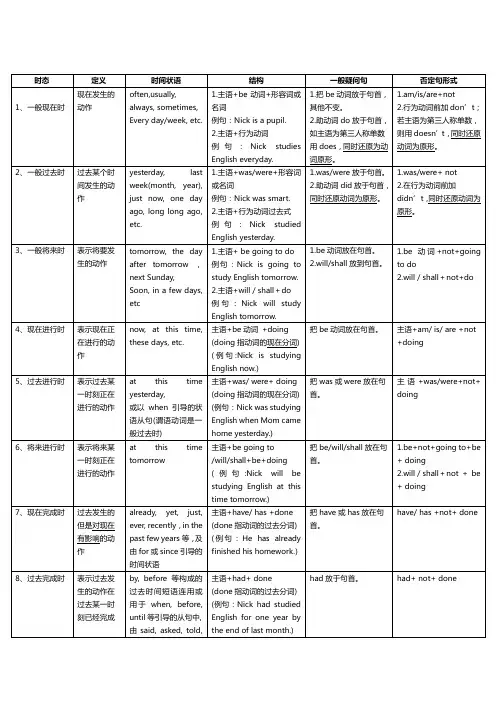
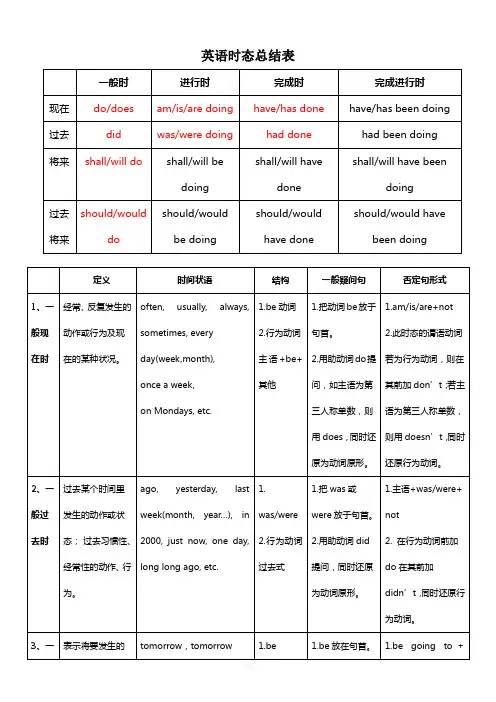
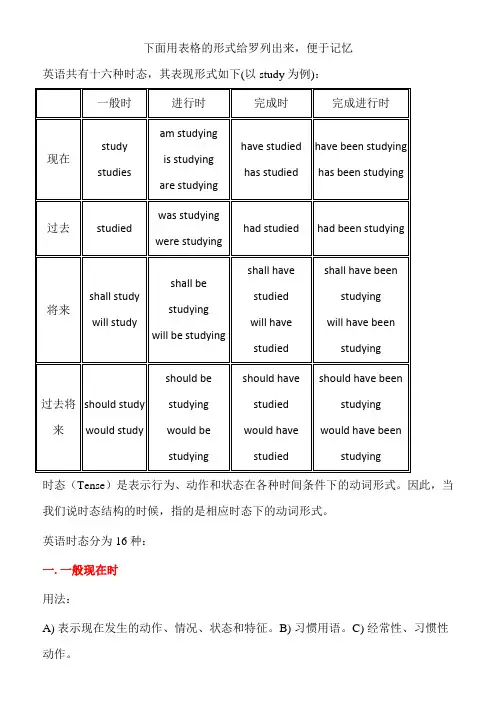
下面用表格的形式给罗列出来,便于记忆英语共有十六种时态,其表现形式如下(以study为例):时态(Tense)是表示行为、动作和状态在各种时间条件下的动词形式。
因此,当我们说时态结构的时候,指的是相应时态下的动词形式。
英语时态分为16种:一. 一般现在时用法:A) 表示现在发生的动作、情况、状态和特征。
B) 习惯用语。
C) 经常性、习惯性动作。
D) 客观事实和普遍真理。
尤其要注意,如果前后文不是一般现在时,则无法保持主句、从句时态一致。
E) 表示一个按规定、计划或安排要发生的动作,(仅限于某些表示“来、去、动、停、开始、结束、继续”等的动词)可以与表示未来时间的状语搭配使用。
常见的用法是:飞机、火车、轮船、汽车等定期定点运行的交通方式。
例:The next train leaves at 3 o'clock this afternoon.(下一趟火车今天下午3点开车。
)How often does this shuttle bus run? (这班车多久一趟?)F) 在时间和条件状语从句里经常用一般现在(有时也用现在完成时)表示将来事情。
时间状语:always, usually, often, sometimes, every week (day, year, month…), once a week, on Sundays, etc.基本结构:①be动词;②行为动词否定形式:①am/is/are+not;②此时态的谓语动词若为行为动词,则在其前加don't,如主语为第三人称单数,则用doesn't,同时还原行为动词。
一般疑问句:①把be动词放于句首;②用助动词do提问,如主语为第三人称单数,则用does,同时,还原行为动词。
二. 一般过去时用法:A) 表示过去某个时间发生的动作或情况。
B) 表示过去习惯性动作。
特别是由would/ used to do表达的句型,本身表示的就是过去时。
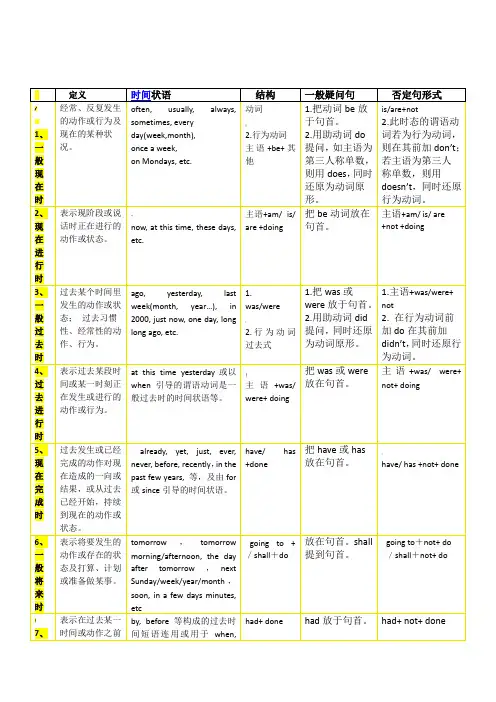
,过去完成时态练习题一.用动词的适当形式填空1. We _____________ (paint) the house before we ______________ (move) in.2. That rich old man _____________ (make) a will before he_____________ (die).3. They _____________ (study) the map of the country before they ________ (leave).4. The robbers _____________ (run away ) before thepolicemen_______ (arrive).5. I __________ (turn off) all the lights before I ____________ (go) to bed.6. Paul __________ (go) out with Jane after he __________ (make) a phone call.?7. Tom __________ (say) he ___________ (read) the book twice.8. Our plan ____________ (fail ) because we _____________ (make) a bad mistake.9. When the chairman ______________ (finish) speaking, he_____________ (leave)the hall.Reads __ ______ (have) lunch when I ________________(get) to their house.I ______________(arrive) at the station, he____________________(leave)._______________(learn) about 4000 English words by the end of last term.13. I waited until he _______________(finish) his homework.14. We were surprised at what she ________already ______(do)$____________(not go) to Qingdao because she ________________ (be) there before.16. He ______________(not tell) you the news yet.17. He said he _____________already_________(give) the book to the teacher.18. I ______________(be) to Shanghai before.19. She told me she _________________(be) to Sanya three times._____________(play) the guitar while hersister_______________(sing).二.句型转换1.I had sold the ticket when she came.(改否定句)`had sung a song to us before she danced.(改否定句)began to climb the mountain after they had bought all the food and drinks.(否定)10:00 a.m, I had been very hungry. (改一般疑问)had already completed the project when I arrived.(改一般疑问);the time he got to the airport, the plane had taken off. (改一般疑问)7..He had broken his arm when I saw him.(对划线部分提问)he had read the note, he ate it. (对划线部分提问)9..Jack didn’t go t o the cinema because he had seen the film. (对划线部分提问);had had the toys for ten years before we gave them to the child. (对划线部分提问)had written the book by the end of 1960. (对划线部分提问)cooked the dumplings. We ate them up. (用过去完成时连接两句)’s father mended the car. It was broken. (用过去完成时连接两句)》had our tests. Then we had a long holiday.( 用过去完成时连接两句) After we ________________________, we_____________________________showed us the picture. Then he showed us around the house. 用过去完成时连接两句)Before he _______________________,he______________________________.练习二一、单选"1 When Li Ming hurried home,he found that his mother____already____to hospital.A has;been sentB had;sentC has;sentD had;been sent2 We ____five English songs by the end of last term.A had learnedB learnedC have learnedD will have learned3 Han Mei told me she _____lunch,so she was very hungry.A has hadB hasn't haveC have hadD hadn't had4 By the end of 1976,many buildings _____built in the city.A have beenB haveC had beenD will~5 She _____her keys in the office so she had to wait until her husband____home.A has left;comesB had left;would comeC had left;cameD left;had come6 He said that it was at least ten years since I _____a good drink.A had enjoyedB was enjoyingC have enjoyedD have been enjoying7 The meeting _____when Mr. Wang _____to school.A has begun;getB has been on;getC had begun;gotD had been on;got二、填空1 When I returned home,he _____ (leave)。

英语十六种时态表格总结一、一般现在时(Simple Present)人称/主语动词第一人称单数I work第二人称单数You work第三人称单数He/She/It works第一人称复数We work第二人称复数You work第三人称复数They work一般现在时表示经常性或习惯性的动作、现阶段的状态或客观事实等。
二、一般过去时(Simple Past)人称/主语动词第一人称单数I worked第二人称单数You worked第三人称单数He/She/It worked第一人称复数We worked第二人称复数You worked第三人称复数They worked一般过去时表示过去某个时间发生的动作或存在的状态。
三、一般将来时(Simple Future)人称/主语动词第一人称单数I will work第二人称单数You will work第三人称单数He/She/It will work第一人称复数We will work第二人称复数You will work第三人称复数They will work一般将来时表示将来某个时间要发生的动作或存在的状态。
四、现在进行时(Present Continuous)人称/主语动词第一人称单数I am working第二人称单数You are working第三人称单数He/She/It is working第一人称复数We are working第二人称复数You are working第三人称复数They are working现在进行时表示当前正在进行的动作或发展趋势。
五、过去进行时(Past Continuous)人称/主语动词第一人称单数I was working第二人称单数You were working第三人称单数He/She/It was working第一人称复数We were working第二人称复数You were working第三人称复数They were working过去进行时表示在过去某个时间正在进行的动作。
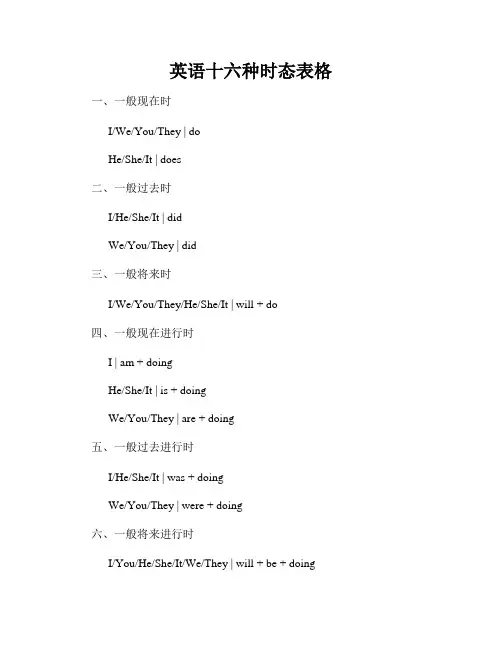
英语十六种时态表格一、一般现在时I/We/You/They | doHe/She/It | does二、一般过去时I/He/She/It | didWe/You/They | did三、一般将来时I/We/You/They/He/She/It | will + do四、一般现在进行时I | am + doingHe/She/It | is + doingWe/You/They | are + doing五、一般过去进行时I/He/She/It | was + doingWe/You/They | were + doing六、一般将来进行时I/You/He/She/It/We/They | will + be + doing七、一般现在完成时I/You/We/They/He/She/It | have/has + done八、一般过去完成时I/You/We/They/He/She/It | had + done九、一般将来完成时I/You/We/They/He/She/It | will have + done十、现在完成进行时I/You/We/They/He/She/It | have/has been + doing 十一、过去完成进行时I/You/We/They/He/She/It | had been + doing十二、将来完成进行时I/You/We/They/He/She/It | will have been + doing 十三、现在完成时I/You/We/They/He/She/It | have/has + done十四、过去完成时I/You/We/They/He/She/It | had + done十五、将来完成时I/You/We/They/He/She/It | will have + done十六、过去将来时I/You/He/She/It/We/They | would + do以上是英语中的十六种时态及其对应的动词形式。
{英语十六时态表格总结(很全面)目录122345 >7 (7) (7) (7) (7) (8) (9) (9)- (9)11 (11)11 (11) (12),英语共有16种时态!常用的有12个:一般现在时、一般过去时、一般将来时、过去将来时、现在进行时、过去进行时、将来进行时、现在完成时、过去完成时、将来完成时、现在完成进行时和过去完成进行时。
其他时态很少单独使用!下面发部分英语时态表吧!希望能对你们有帮助!一般现在时、一般过去时一般将来时、过去将来时现在进行时、过去进行时现在完成时、过去完成时英语时态表—英语时态举例!详细讲解-一般现在时通常以动词原形表示。
主语为第三人称单数时,用现单三形式。
详细讲解-现在进行时、一般过去时现在进行时一般过去时一般过去时通常由动词过去式表示。
一般过去时的否定式、疑问式和简单回答形式要用助动词do 的过去式did, 同时注意实义动词要用原形。
以study 为例,其否定式、疑问式和简单回答形式如下:详细讲解-过去进行时、过去完成时、过去进行时由助动词be 的过去式+现在分词构成。
其中be有人称和数的变化,第一、第三人称单数用was,其他用were.1)过去进行时动词主要表示在过去某一时刻或某一段时间内正在进行或持续进行的动作。
过去进行时经常与过去时配合使用。
例如:This time yesterday, we were having an English lesson. 昨天这个时候,我们正在上英语课。
The teacher was giving us a lesson when Tom walked into the room. 老师在给我们上课时,汤姆走进教室。
While we were having supper, all the lights went out. 我们吃饭的时候,灯灭了。
He was reading while she was setting the table. 她摆桌子时,他在读书。
英语16种时态表格总结各时态结构及具体用法:1.一般现在时(do/does; is/am/are)①表示现在的情况、状态和特征。
例:He is a student.他是一个学生。
②表示经常性、习惯性动作。
例:He always helps others.他总是帮助别人。
③客观事实和普遍真理。
例:The earth moves the sun.地球绕着太阳转。
④表示一个按规定、计划或安排要发生的动作。
(常用于列车、客车、飞机或轮船时刻表)例:The next train leaves at 3 o'clock this afternoon.下一趟火车今天下午3点开车。
⑤主将从现:在时间、条件和让步状语从句中经常用一般现在表示将的来事情。
例:If it rains tomorrow, we will stay at home.如果明天下雨,我们会待在家里。
2.现在进行时(am/is/are doing)①表示此时此刻正在发生的事情。
例:He is listning to the music now.他现在正在听音乐。
②表示目前一段时间内一直在做的事情,但不一定此时此刻正在做。
例:I am studying computer this term.这个学期我一直在学习计算机。
③现在进行时可以表示将来的含义。
瞬时动词的进行一定表将来。
例:I am leaving.我要离开了。
持续动词的进行只有有将来的时间状语或有将来语境中才表将来。
例:I am travelling next month.下个月我要去旅行。
④现在进行时与频度副词连用,表示说话者或褒义或贬义的感情色彩。
例:He is always helping others.他总是帮助别人。
(褒义)3.过去进行时(was/ were doing)①表示在过去一个具体的时间正在发生的动作。
例:Mary was listening to light music 10 minutes ago.10分钟前,玛丽正在听轻音乐。
英语时态总结表一般时进行时完成时完成进行时现在do/doesam/is/aredoing have/hasdone have/hasbeendoing过去did was/weredoing haddone hadbeendoing将来shall/willdoshall/willbedoing shall/willhavedoneshall/willhavebeendoing过去将来should/woulddoshould/wouldbedoingshould/wouldhavedoneshould/wouldhavebeendoing 定义时间状语结构一般疑问句否定句形式1、一般现在时经常、反复发生的动作或行为及often,usually,always,sometimes,everyday(week,month),onceaweek,onMondays,etc.1.be动词2.行为动词主语+be+其他1.把动词be放于句首。
2.用助动词do提问,如主语为第三人称单数,则用does,同时还原为动词原形。
1.am/is/are+not2.此时态的谓语动词若为行为动词,则在其前加don’t;若主语为第三人称单数,则用doesn’t,同时还原行为动词。
在的某种状况。
2、一般过去时过去某个时间里发生的动作或状态;过ago,yesterday,lastweek(month,year…),in2000,justnow,oneday,longlongago,etc.1.was/were2.行为动词过去式1.把was或were放于句首。
2.用助动词did提问,同时还原为动词原形。
1.主语+was/were+not2.在行为动词前加do在其前加didn’t,同时还原行为动词。
习惯性、经常性的动作、行为。
3、一般将来时表示将要发生的动作或存tomorrow,tomorrowmorning/afternoon,thedayaftertomorrow,nextSunday/week/year/month,soon,inafewdaysminutes,etc1.begoingto+do2.will/shall+do1.be放在句首。